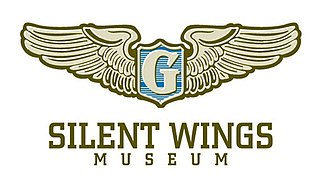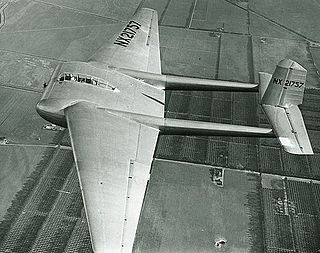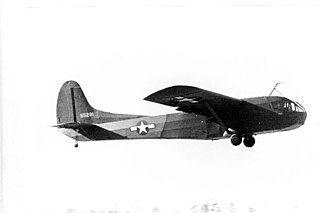
The Curtiss JN "Jenny" was a series of biplanes built by the Glenn Curtiss Aeroplane Company of Hammondsport, New York, later the Curtiss Aeroplane and Motor Company. Although the Curtiss JN series was originally produced as a training aircraft for the US Army, the "Jenny" continued after World War I as a civilian aircraft, as it became the "backbone of American postwar [civil] aviation".

The de Havilland Canada DHC-4 Caribou is a Canadian specialized cargo aircraft with short takeoff and landing (STOL) capability. The Caribou was first flown in 1958 and although mainly retired from military operations, is still in use in small numbers as a rugged bush airplane.

The Airspeed AS.51 Horsa was a British troop-carrying glider used during the Second World War. It was developed and manufactured by Airspeed Limited, alongside various subcontractors; the type was named after Horsa, the legendary 5th-century conqueror of southern Britain.

The Avro Canada CF-100 Canuck is a Canadian twinjet interceptor/fighter designed and produced by aircraft manufacturer Avro Canada. It has the distinction of being the only Canadian-designed fighter to enter mass production.

The General Aircraft GAL.48 Hotspur was a military glider designed and built by the British company General Aircraft Ltd during World War II. When the British airborne establishment was formed in 1940 by order of Prime Minister Winston Churchill, it was decided that gliders would be used to transport airborne troops into battle. General Aircraft Ltd were given a contract by the Ministry of Aircraft Production in June 1940 to design and produce an initial glider for use by the airborne establishment, which resulted in the Hotspur.

The Slingsby Hengist was a British military glider designed and built by Slingsby Sailplanes Ltd. Like other British troop carrying gliders in the Second World War, it was named after military figures whose name began with H, in this case the Jute invader Hengist.

The Lockheed YO-3 Quiet Star is an American single-engined, propeller-driven aircraft that was developed for battlefield observation during the Vietnam War. Designed to be as quiet as possible, it was intended to observe troop movements in near-silence during the hours of darkness.

Military gliders have been used by the militaries of various countries for carrying troops and heavy equipment to a combat zone, mainly during the Second World War. These engineless aircraft were towed into the air and most of the way to their target by military transport planes, e.g., C-47 Skytrain or Dakota, or bombers relegated to secondary activities, e.g., Short Stirling. Most military gliders do not soar, although there were attempts to build military sailplanes as well, such as the DFS 228.

The Aeronca L-3 group of observation and liaison aircraft were used by the United States Army Air Corps in World War II. The L-3 series were adapted from Aeronca's pre-war Tandem Trainer and Chief models.

Silent Wings Museum, "The Legacy of The World War II Glider Pilots," is a museum in Lubbock, Texas. The museum is housed in the former tower and terminal building of Lubbock's airport during the 1950s, and 1960s.

The Percival Pembroke is a British high-wing twin-engined light transport aircraft built by the Percival Aircraft Company, later Hunting Percival.

The Learjet 24 is an American six-to-eight-seat twin-engine, high-speed business jet, which was manufactured by Learjet as the successor to the Learjet 23.

The XCG-16 was a military transport/assault glider ordered by the United States Army Air Forces (USAAF), from General Airborne Transport Co., for competition against the Waco CG-13A at Wright Field. The XCG-16’s preferred tow aircraft was the Lockheed Model 18 Lodestar.

The Waco CG-15 was an American military glider, which was developed from the CG-4. Although outwardly similar to its predecessor and carrying the same number of passengers, a number of changes in the design, including shortened wings and a more streamlined nose enabled it to travel faster. 1,000 were ordered and 473 were delivered before production ceased. Two were transferred to the Navy for testing as the XLR2W-1. One unit was converted into an XPG-3 powered glider which used two Jacobs R-755-9 radial engines.

The Cessna Model CG-2 was an American primary glider built by the Cessna Aircraft Company in the early 1930s.

The Waco CG-13 was an American military transport glider aircraft developed during World War II.

The Laister-Kauffmann TG-4 was a sailplane produced in the United States during the Second World War for training cargo glider pilots. It was a conventional sailplane design with a fuselage of steel tube construction and wooden wings and tail, covered all over with fabric. The pilot and instructor sat in tandem under a long canopy.

Laurinburg–Maxton Army Air Base is an inactive United States Air Force base, approximately 6 miles east-northeast of Laurinburg, North Carolina. It was active during World War II as a I Troop Carrier Command training airfield.

The Pratt-Read TG-32 was a 1940s American military training glider, designed and built by the Gould Aeronautical Division of the piano manufacturer Pratt, Read & Company of Deep River, Connecticut, for the United States Navy. The Pratt-Read glider was a monoplane glider having a fabric-covered steel tube fuselage and wooden wings and tail. The unique "polywog (tadpole)" shape was the suggestion of aerodynamicist Charles Townsend Ludington, former owner of the Ludington Line.
The WACO Air Museum is an aviation museum located in Troy, Ohio focused on the history of the Waco Aircraft Company.




























